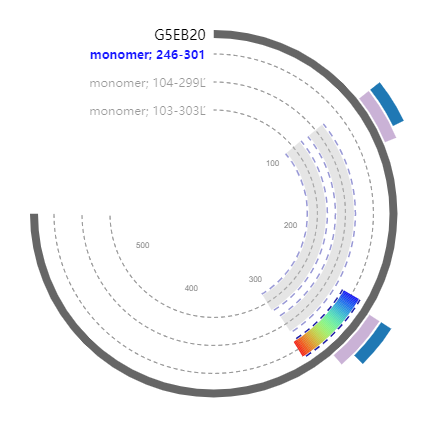oxidoreductase activity.
MLASIPHMETLRSLPRNPDVVARHPSAEDLDAAQQLISSAQAGREHPQDRHYTDNGSRKS
EAGAPHSHHEGEYPIVQTSETPMNGHHVEKTSPKSQKDTSFLGHSCSNCGTKSTPLWRRS
PTGAMICNACGLYLKARNVARPTKRNRTQASPEAYHPQNQSVGSQPDPAVTGSEGCTGSC
PGGGNCNGTGGAEGCDGCPAYNNRVYKSTARGNVAAHALNRAGNSDAVPSPEAEAPARNS
GQPEGNMLVACQNCGTTVTPLWRRDENGHPICNACGLYYKLHGSYRPTTMKKTIIKRRKR
VVPALRENSPTAATHSSHGSSASPEASSPATLAYSHDERHRYYSSEPVDQYHRISPAAQR
PFGFAPPPVDFTNFNSGAVTLPHHPPPPRLLEPGHPPLSQFARRSISPSSSGNSKKRTLA
EAGANTDTGPVPTTLEAGSNQLPPIVSSANPPPPARLSSISSILNHAHARDESRLDPSLA
ALGRQQQSQPHHPQSSPLAPTQAASQSLPGVSNMDNHVEDRRAKLQREAEEMREQLRAKE
RELAELAGQ
559

| PMID | Title & Author | Abstract | Year | |
| 0 | 31107632 | The Role of SreA-Mediated Iron Regulation in Maintaining Epichloë festucae- Lolium perenne Symbioses. Natasha T Forester , Geoffrey A Lane , Catherine M McKenzie , Iain L Lamont , Linda J Johnson | In ascomycetes and basidiomycetes, iron-responsive GATA-type transcriptional repressors are involved in regulating iron homeostasis, notably to prevent iron toxicity through control of iron uptake. To date, it has been unknown whether this iron regulator contributes toward mutualistic endosymbiosis of microbes with plants, a system where the endophyte must function within the constraints of an in-host existence, including a dependency on the host for nutrient acquisition. Functional characterization of one such protein, SreA from Epichloë festucae, a fungal endosymbiont of cool-season grasses, indicates that regulation of iron homeostasis processes is important for symbiotic maintenance. The deletion of the sreA gene (ΔsreA) led to iron-dependent aberrant hyphal growth and the gradual loss of endophyte hyphae from perennial ryegrass. SreA negatively regulates the siderophore biosynthesis and high-affinity iron uptake systems of E. festucae, similar to other fungi, resulting in iron accumulation in mutants. Our evidence suggests that SreA is involved in the processes that moderate Epichloë iron acquisition from the plant apoplast, because overharvesting of iron in ΔsreA mutants was detected as premature chlorosis of the host using a hydroponic plant growth assay. E. festucae appears to have a tightly regulated iron management system, involving SreA that balances endophyte growth with its survival and prevents overcompetition with the host for iron in the intercellular niche, thus promoting mutualistic associations. Mutations that interfere with Epichloë iron management negatively affect iron-dependent fungal growth and destabilize mutualistic Epichloë -ryegrass associations. | 2019 |
| 1 | 11555288 | SREA is involved in regulation of siderophore biosynthesis, utilization and uptake in Aspergillus nidulans. H Oberegger , M Schoeser, I Zadra, B Abt, H Haas | Under conditions of low iron availability, most fungi excrete siderophores in order to mobilize extracellular iron. We show that lack of the GATA-type transcription factor SREA in Aspergillus nidulans not only leads to derepression of siderophore biosynthesis but also to deregulation of siderophore-bound iron uptake and ornithine esterase expression. Furthermore, SREA deficiency causes increased accumulation of ferricrocin, the siderophore responsible for intracellular iron storage. In sreA deletion strains, extracellular siderophore production is derepressed but still regulated negatively by iron availability, indicating the presence of an additional iron-regulatory mechanism. In contrast, iron affects ferricrocin accumulation in a positive way, suggesting a protective role for this siderophore in detoxification of intracellular iron excess. The harmfulness of deregulated iron uptake in this mutant is demonstrated by increased expression of genes encoding the antioxidative enzymes catalase CATB and the superoxide dismutases SODA and SODB. It is noteworthy that iron starvation was found to repress catB expression in wild-type (wt) and SREA-deficient strains, consistent with catB being subject to SREA-independent iron regulation. Differential display led to the identification of putative SREA target genes amcA and mirA. The deduced MIRA amino acid sequence displays significant similarity to recently characterized siderophore permeases of Saccharomyces cerevisiae. amcA encodes a putative mitochondrial carrier for the siderophore precursor ornithine, indicating cross-regulation of siderophore and ornithine metabolism. | 2001 |
| 2 | 12949162 | Membrane-bound hydrogenase and sulfur reductase of the hyperthermophilic and acidophilic archaeon Acidianus ambivalens. Simone Laska , Friedrich Lottspeich , Arnulf Kletzin | A sulfur reductase (SR) and a hydrogenase were purified from solubilized membrane fractions of anaerobically grown cells of the sulfur-dependent archaeon Acidianus ambivalens and the corresponding genes were sequenced. The SR reduced elemental sulfur with hydrogen as electron donor [45 U (mg protein)(-1)] in the presence of hydrogenase and either 2,3-dimethylnaphthoquinone (DMN) or cytochrome c in the enzyme assay. The SR could not be separated from the hydrogenase during purification without loss of activity, whereas the hydrogenase could be separated from the SR. The specific activity of the hydrogenase was 170 U (mg protein)(-1) with methyl viologen and 833 U (mg protein)(-1) with DMN as electron acceptors. Both holoenzymes showed molecular masses of 250 kDa. In SDS gels of active fractions, protein bands with apparent masses of 110 (SreA), 66 (HynL), 41 (HynS) and 29 kDa were present. Enriched hydrogenase fractions contained 14 micro mol Fe and 2 micromol Ni (g protein)(-1); in addition, 2.5 micromol Mo (g protein)(-1) was found in the membrane fraction. Two overlapping genomic cosmid clones were sequenced, encoding a five-gene SR cluster (sre) including the 110 kDa subunit gene (sreA), and a 12-gene hydrogenase cluster (hyn) including the large and small subunit genes and genes encoding proteins required for the maturation of NiFe hydrogenases. A phylogenetic analysis of the SR amino acid sequence revealed that the protein belonged to the DMSO reductase family of molybdoenzymes and that the family showed a novel clustering. A model of sulfur respiration in Acidianus developed from the biochemical results and the data of the amino acid sequence comparisons is discussed. | 2003 |
Laska S , Lottspeich F , Kletzin A . Membrane-bound hydrogenase and sulfur reductase of the hyperthermophilic and acidophilic archaeon Acidianus ambivalens[J]. Microbiology, 2003, 149(Pt 9):2357-2371.